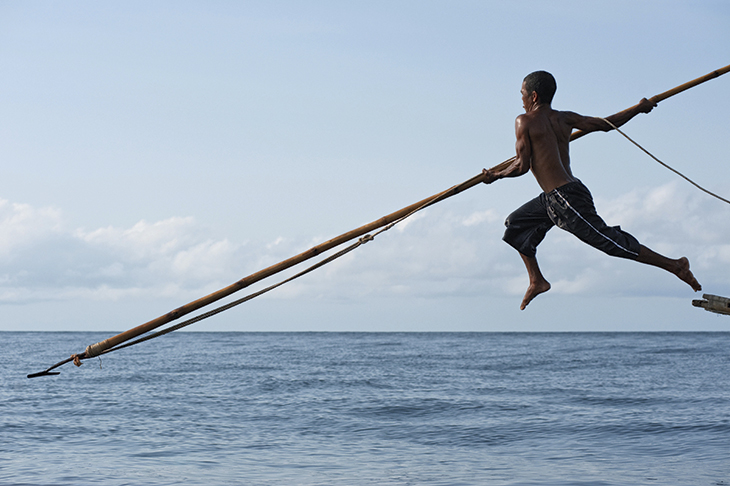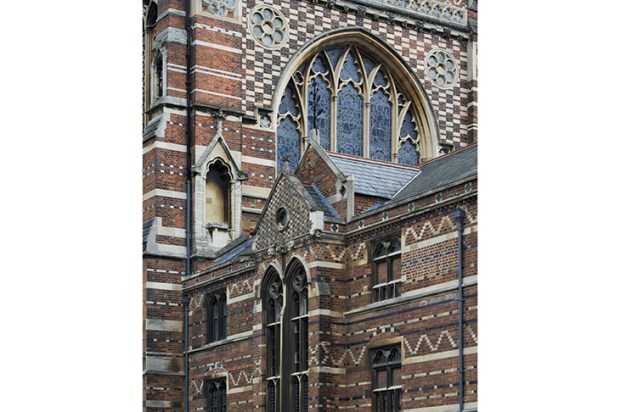Our relations with cetaceans have always been charged with danger and delight, represented by the extremes of the Book of Revelation’s ‘beast out of the sea’, and the frescoed dolphin-riders of Pompeii. Rare, huge, and unknowable, whales have traditionally been omens, or metaphors for improbability — ‘very like a whale’, Hamlet chaffs the cloud-watching Polonius. They were long chased by daring Basques, Icelanders and Inuit, and prized whenever they washed up — they were declared ‘Fishes Royal’ by Edward II — but then they met 18th-century modernity.
Soon they were harried almost to extinction by fleets from New England as well as old, France, Holland and Norway, seeking baleen for corsets and chimney-brushes, oil to light the lamps of the Age of Reason, and ambergris to fix its perfumes. Taxonomised by Linnaeus in 1758, the sperm whale came increasingly to occidental attentions, its great head a-swim with spermaceti, its skin bearing scars of suckers of Kraken-like giant squid bested in black gulfs. Whaling museums from Hull to Nantucket display sad skeletons and scrimshaw, naive scenes inked on to sperm teeth by off-watch hands. (A sperm whale from Holderness is mentioned in Moby-Dick.)
As petroleum superseded spermaceti, westerners started to see whales through warmer eyes. These were no cold fish but big-brained, long-lived, social mammals, and furthermore they ‘sang’ across seas of time and space. Pressure built to preserve them from modern Ahabs with unchivalrous high-tech harpoons. The moratorium in 1982 on commercial whaling made exceptions for aboriginal whalers scattered around the blue planet from the Faroes to Alaska, who took whales in small numbers, using ancient methods. These amphibious autochthons included the Lamalerans of Indonesia’s Lembata, an island so remote even Indonesians call it ‘the land left behind’.
Lamalerans made landfall on Lembata in Indonesia in around 1522, even as Magellan was exploring the archipelago, and commenced a hazardous, laborious dependency on the bounteous fruits of the Suva Sea. They hunted dolphins, rays, sharks and sperm whales from lashless lug téna boats built without nails, copying the craft that had carried the ancestors, incorporating old timbers and investing every rope with significance. Christianity came late, existing illogically alongside animism — the Mass of Lost Souls abutting the Ige Gerek, the Calling of Whales by the hereditary lords of the land. Lamaleran women still clean, cook, kill fowl, trek to market and, in rare spare moments, weave immemorial motifs into itak cloth and men butcher, lop lianas, raise houses, careen keels or occasionally war, while keeping ‘burning eyes’ oceanward and ears attuned for the shout ‘Baleo!’ — the hunt is on.
Doug Bock Clark first visited Lamalera in 2011. Most outsiders move on swiftly, bored waiting for whales to blow, but he returned, and learned the language. Some quixotic side was captivated by this community on the literal and metaphorical edge, as its anchors dragged and its youngsters drifted off dismasted to jobs in the city, exchanging harpoons for mobiles, and sarongs for Hello Kitty T-shirts. He shows us this outpost in all its aspects, a village simultaneously enhaloed and smelling of fish. He relishes queasy details — messes of rays’ brains, fish-eye snacks — and the plangently attenuated, such as the Spear of the Dragon which once promised victory in battle, but is now a rusty walking-stick.
His unjaded Lamalerans are more admirable than westerners — angst-haunted, he aspires to be ‘a little less American’ — still thinking in cycles and generations, seeing benefits as gifts from gods rather than human rights. He badly wants to believe community can be reconciled with opportunity, and conservationists can come to see very human folk ways as wholly natural evolutions. To him, the jets overflying the archipelago emblematise uncertain escape, looking like harpoons with rope contrails —projectiles launched into space without anyone knowing where they’ll land.
Vanishing venery, howsoever humanised or hymned, will not be universally appealing; but the real threats to whales lie far beyond the land left behind. European bestiarists believed whales exhaled sweet odours to attract fish; now their great gapes attract shopping bags instead, dooming noble beasts to squalid ends, such as the one found last month in the Philippines with 40 kilos of plastic balled in its guts. No brave whaler could ever be so dirtily profligate.
For a little longer, those few who persist in pursuing Physeter macrocephalus have the ultimate antidote to modern anomie, in moments when all pull together, or leap on to the backs of 60-ton titans, whose flukes flail death. Sometimes Indonesian Actæons go down for good, becoming phyloplankton, or phosphorescence on the face of waters mirroring the homeward-pointing Southern Cross and the star-showers of Cetus (named after the sea beast beheaded by Perseus). Unrecovered bodies are interred symbolically, represented by nautiluses, suitably ancient-shaped, fragile but shining, like Jonah emerging from the abyss as eternal example. The Last Whalers should serve similarly as a tribute to this tribe, and all the others, foundering in or riding out the ‘typhoon of life’.
Got something to add? Join the discussion and comment below.
Get 10 issues for just $10
Subscribe to The Spectator Australia today for the next 10 magazine issues, plus full online access, for just $10.
You might disagree with half of it, but you’ll enjoy reading all of it. Try your first month for free, then just $2 a week for the remainder of your first year.














Comments
Don't miss out
Join the conversation with other Spectator Australia readers. Subscribe to leave a comment.
SUBSCRIBEAlready a subscriber? Log in